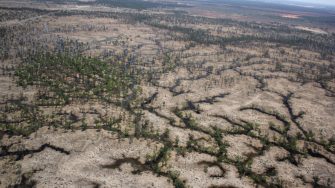
Date: Monday, November 9, 2015
Project: Eastern Australian Waterbird Survey
Observer: Richard Kingsford
We began by surveying Band 3, the eastern part of the our eastern Australian waterbird survey, because we low cloud had stopped us surveying this earlier in October. We began with three large dams with few waterbirds: Fitzroy Falls Dam, Wingecarribee Reservoir and Pejar Dam.
Survey of Fitzroy Falls Dam
Pejar Dam on the Southern Tablelands of NSW
This part of our survey, the next two weeks, focused on the Murray-Darling Basin’s major wetland assets which we had not already picked up over the survey. After we had finished Band 3 of the eastern Australian waterbird survey, we headed west to Lake Cowal. Last year it was drying back and I had predicted it would be dry this year – wrong. It was only about 40% full but absolutely vibrant with tens of thousands of waterbirds of many different species. When these wetlands become shallow like Lake Cowal, they are incredibly productive and the waterbirds on this lake tell the story.
Surveying tens of thousands of waterbirds on Lake Cowal
From here, we went down the Lachlan, one of the big rivers of the Murray-Darling Basin. On the way Lake Ballyrogan, now called Lake Brewster, is used to store water but it was dry. Sometimes it can have thousands of waterbirds including breeding pelicans.
A dry Lake Brewster
Further south, the Lachlan River splits into a distributary, the Booligal system and the Cumbung system. Environmental flows were working their magic down both. There were plenty of waterbirds although clearly not sufficient flows to trigger breeding. The straw-necked ibis were in large numbers in both the Booligal and also the Cumbung system. The environmental flows had spread down to the southern part of the Cumbung system.
The Cumbung Swamp and its reedbeds, showing the flooding which creates large areas of habitat for waterbirds.
The environmental flows created amazing patterns as they seep through the river red gum forests of the Cumbung system
Even down here, there are lakes which hold water and provide habitat for waterbirds and also for the people who depend on these systems.
